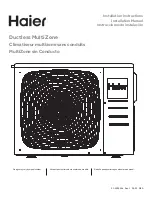
24
INSTALLATION OPERATIONS AND MAINTENANCE MANUAL - RXC/Hi SERIES
11. SAFETY AND CONTROL DEVICES
• Supply air temperature probe
Passive sensor type NTC 10kΩ. Positioned on the supply air side, downstream of the heating/cooling units, it is used to monitor
the temperature of the air supplied to the room. It is installed in combination with the temperature control accessories (water
coils or post-heating electric resistance). Through this probe it is also possible to control eventual air delivery temperatures in
the environment that are too cold in summer or too hot in winter.
• Return air temperature probe
Passive sensor type NTC 10kΩ. Positioned on the room air intake and upstream of the filtering section, its purpose is to mon-
itor the temperature of the air extracted from the room to be treated. Always present in all units, it is used as a control probe
of the room temperature set and for the management of the summer free-cooling function.
• Outdoor air temperature probe (fresh air)
Passive sensor type NTC 10kΩ. Positioned on the fresh air intake and upstream of the filtering section, it is used for monitoring
the temperature of the fresh air entering the heat recovery unit. Always present in all units, it is used in combination with the
room air intake temperature probe to manage the summer free-cooling function.
• Exhaust air temperature probe
Passive sensor type NTC 10kΩ. Positioned on the air outlet and downstream of the plate heat exchanger, it monitors the tem-
perature of the air exhausted from the unit. It is installed in combination with the defrosting kit with the function of controlling
the exhaust temperature of the plate heat exchanger in order to avoid freezing of the same during the winter operation of
the unit.
• Source exchanger defrost kit
The source heat exchanger defrost kit is composed of a pressure transducer and a cycle inversion valve, directly managed by
the microprocessor control. In case, in heating mode, the conditions downstream the plate heat exchang should fall below
the ice formation threshold, the defrost system would activate, which would invert the refrigerant gas flow andsend hot gas
to the heat exchanger to defrost.
As soon as the conditions downstream the heat exchanger would allow, the heating operating mode would be reset.
• Differential pressure switch
This component is used to monitor the clogging status of the air filters. There are two pressure switches for each unit, one
installed on the fresh air filter section and one located on the room return air filter section. If one of the filters has a pressure
difference greater than the recommended limit, an alarm is displayed on the user interface.
• Differential pressure transducer
Active type transducer with 4-20mA output signal. It is located inside the control board and connected to the supply fan pres-
sure sockets. The task is to maintain the air volume as constant at the variation of the internal pressure drop (dirtying of the
filters).
• Low pressure switch
The low pressure switch stops the unit when the suction gas pressure is lower than the default value. The reset is automatic
and it takes place when the gas pressure is superior to the set differential value. The pressure switch is set to allow for a maxi-
mum of 3 automatic resets per hour.
• High pressure switch
The high pressure switch stops the unit when the supply gas pressure is above default value. The reset is automatic and it
takes place when the gas pressure is below the set differential value. The pressure switch is set to allow for a maximum of 3
automatic resets per hour.
• Compressor discharge temperature sensor
Passive NTC-type sensor mounted on the compressor discharge side, used to limit the discharge gas temperature.
















































